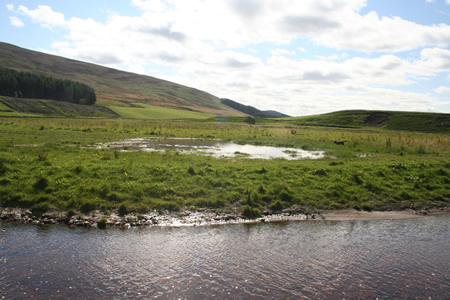These bulletin blogs represent news about Finavon and the South Esk, and my views as a riparian owner. They are not the views of any other organisation, nor are they designed to promote the interests of any individual or organisation other than Finavon Castle Water and factors affecting the fishery. Tony Andrews
It is a while since we have seen (and felt!) such cold weather. In past years – I mean the 1980s – the dyke at Upper Kinnaird stopped nearly all spring salmon until the water temperature reached 42F. Since the dam was improved by the simple but brilliant expedient of installing hard wood baffles to reduce the flow through the fish pass, salmon have been able to get up river in all but the coldest water temperatures. With those temperatures not exceeding 36F in the last four weeks I guess that nearly every salmon entering the river has been held up by what is still a major obstacle in an otherwise relatively ‘easy’ river for ascending fish.
This was the view from the Red Brae hut looking upstream towards the suspension bridge on the 27th of March 2013. Thinking back to March 2012, we had warm weather, a drought and poor fishing conditions. This year it is minus 5.C. at night and struggles to get to plus 3.C. in the day. But today (Easter Saturday) was bright and sunny with the river clear and cold and the hills pure white. While fresh fish are being caught at Upper Kinnaird I feel that there isn’t much going on at Finavon, not yet at any rate!
Prior to the current cold spell it appears that some salmon did get into the river above Brechin, but I think not very many. The proof is in the pudding. Upper Kinnaird now shows catches of 20 salmon – from 6lbs to 20lbs, all of them in tip-top condition – and Marine Scotland has been able to trap at least a further three fish for in-river tagging. Upper Kinnaird, as it always was pre 1990, is again the top beat showing on the Esks Fishpal website for spring salmon in 2013. That is great news for the South Esk.
I have long argued that we don’t have any reliable data on early running salmon in the South Esk. I make that claim because, with Kinnaird dyke now allowing salmon access to the river in all but the very coldest conditions, the fish disperse throughout the system once they are above the dyke. The relatively few salmon that run the river in February and March are normally not concentrated into a few hundred yards of river below the dyke, as they are this year. I therefore feel reassured by the Upper Kinnaird return for March 2013 because it shows that salmon in prime condition, and therefore capable of producing numerous, high quality eggs, are entering the river in the early season. These spring fish will mostly lay their eggs in the upper catchment, in places like the newly restored Rottal Burn, to regenerate the river’s populations of spring salmon.
This photo (above) shows the Rottal Burn and wetland in Glen Clova during the year when the Rottal Burn was restored to approximately its eighteenth century course. During the winter of 2013/2014 there was evidence of spawning activity in this newly restored section of the burn. If we have a good run of spring salmon in 2013 it is to places like Rottal that the fish will go to make their redds and lay their eggs.
Good news indeed! Well done to Adam Carr and his fishing friends, who had a great week’s fishing with ten salmon caught and returned at Upper Kinnaird in perishingly cold conditions!
As I mentioned in a previous blog, there are huge amounts of snow and ice sitting in the hills above us. Ideally we now need a protracted thaw – not too sudden – that leaks a flow of clean fresh water into the river. We don’t need a sudden rise in temperature to bring a big flood through the system and draw the waiting spring run straight into the upper catchment. For middle beats, such as Finavon, we need a gradual rise in water temperatures over the next six weeks the effect of which should be to draw the spring fish up the river incrementally so that the pools fill with fish in stages.
My guess would be that we will see our first salmon caught at Finavon in the week immediately after Easter. It remains to be seen how strong the April and May runs of fish will be. What I can say is that for the reasons set out above, I think it is looking promising…
TA

